反意疑问句知识点总结
反义疑问句句知识点+习题

反义疑问句一、学习反意疑问句,特别要注意的问题1)陈述部分的主语是this, that时,疑问部分的主语多用it;陈述部分的主语是these, those时,疑问部分的主语多用they如:This is a dictionary, isn’t it?Those are shelves, aren’t they?2)陈述句如果是there be结构时,疑问句部分仍用there。
如:There once was a man named Saint Nicholas, wasn’t there?3)在英语口语中,“I am +表语结构”,后面的反意疑问句多用aren’t I来体现。
如:I am very interested in learning English, aren’t I?4)陈述句的主语是动词不定式,动词的-ing形式或从句时,疑问部分的主语多用it来体现。
如:Taking care of our environment is very important, isn’t it?What he said is right, isn’t it?5)陈述句中含有not, no, hardly, neither, never, few, little, too …to等否定词或具有否定意义的词时,疑问部分常用肯定形式。
如:Few people knew the news, did they?Tom has never been to England , has he?但陈述句中如果带有否定意义的前缀和后缀的单词时,整个句子仍视为肯定句,反意疑问部分多用否定形式。
如:She is unhappy, isn’t she?6)陈述句的主语是nobody, no one, everyone, somebody等不定代词时,反意疑问部分的主语多用they (当强调全体时)或he(当强调个体时)。
如果陈述句的主语是something, nothing, anything, everything 等不定代词时,反意疑问部分的主语多用it。
反义疑问句知识点总结

反义疑问句知识点总结反义疑问句的结构看似简单,但在实际应用中却有不少需要注意的地方。
下面将对反义疑问句的用法和构成进行总结,并举例说明,以便对这一语法知识点有更清晰的认识。
一、反义疑问句的构成在构成反义疑问句时,需要注意以下几点:1. 陈述句的肯定/否定形式:陈述句的肯定形式意思是肯定的,而陈述句的否定形式意思则是否定的。
因此,在构成反义疑问句时,需要根据陈述句的肯定/否定形式来选择相应的疑问句形式。
2. 反义疑问句的构成:在构成反义疑问句时,需将陈述句的形式转换为相反意思的形式,并在疑问句后添加相反意思的标点和助动词。
具体来说,如果陈述句为肯定形式,则反义疑问句的陈述部分为否定形式,反之亦然;疑问部分则根据陈述句的形式选择助动词(do/does/did/was/were等)和疑问词(is/are/am/will/can等)。
3. 语气的变化:在口语中,反义疑问句通常用降调的方式发音,从而表达出疑问。
此外,反义疑问句也可用于表达请求、建议、感叹等语气,其语气的变化取决于语境和语气。
二、反义疑问句的用法反义疑问句通常用于以下几种情况:1. 表达疑问:反义疑问句可以用于表达疑问,询问对方对陈述句的意见或确认陈述句的真假。
例如:You aren't coming, are you?(你不会来了,对吗?)2. 表达请求:反义疑问句也可以用于表示请求,请求对方做出回应或行动。
例如:Please open the door, will you?(请你把门打开,可以吗?)3. 表达建议:反义疑问句还可以用于表示建议,向对方提出建议或意见。
例如:Let's go for a walk, shall we?(我们出去散步吧,好吗?)4. 表达感叹:反义疑问句还可以用于表示感叹,表达出惊讶、愤怒、疲倦等情绪。
例如:She is so beautiful, isn't she?(她真漂亮,是吧?)三、反义疑问句的例句以下是一些具体的反义疑问句例句,以便更好地理解其构成和用法:1. He is not going to the party, is he?2. You have finished your homework, haven't you?3. They won't be late, will they?4. She was tired, wasn't she?5. Let's go shopping, shall we?6. You can speak English, can't you?通过以上例句可以清楚地看到反义疑问句的构成和用法,希望能对你理解反义疑问句有所帮助。
九年级反义疑问句知识点
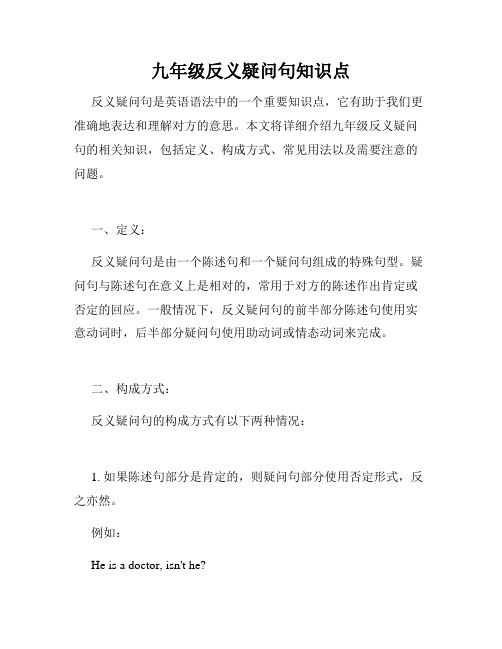
九年级反义疑问句知识点反义疑问句是英语语法中的一个重要知识点,它有助于我们更准确地表达和理解对方的意思。
本文将详细介绍九年级反义疑问句的相关知识,包括定义、构成方式、常见用法以及需要注意的问题。
一、定义:反义疑问句是由一个陈述句和一个疑问句组成的特殊句型。
疑问句与陈述句在意义上是相对的,常用于对方的陈述作出肯定或否定的回应。
一般情况下,反义疑问句的前半部分陈述句使用实意动词时,后半部分疑问句使用助动词或情态动词来完成。
二、构成方式:反义疑问句的构成方式有以下两种情况:1. 如果陈述句部分是肯定的,则疑问句部分使用否定形式,反之亦然。
例如:He is a doctor, isn't he?He isn't a doctor, is he?2. 如果陈述句部分使用助动词或情态动词,疑问句部分使用主要动词。
例如:You can swim, can't you?You can't swim, can you?三、常见用法:九年级阶段,学生需要掌握反义疑问句的常见用法,以下是一些例子:1. 表示请求或征求对方的意见或确认:You will come to the party, won't you?Let's go for a walk, shall we?2. 表示对方的推测并确认:She is your sister, isn't she?3. 表示对方的意见并征求同意或否定:You don't mind if I sit here, do you?4. 表示对方的实际情况并征求确认:You have finished your homework, haven't you?四、需要注意的问题:在使用反义疑问句时,需要注意以下几个问题:1. 人称和时态的一致性:主语的人称和时态需与疑问句的主语相对应,否则会造成语法错误。
例如:She is a doctor, isn't they?(错误)She is a doctor, isn't she?(正确)2. 答案的选择:对于反义疑问句,回答要根据前半部分陈述句而定。
反义疑问句知识点总结全面
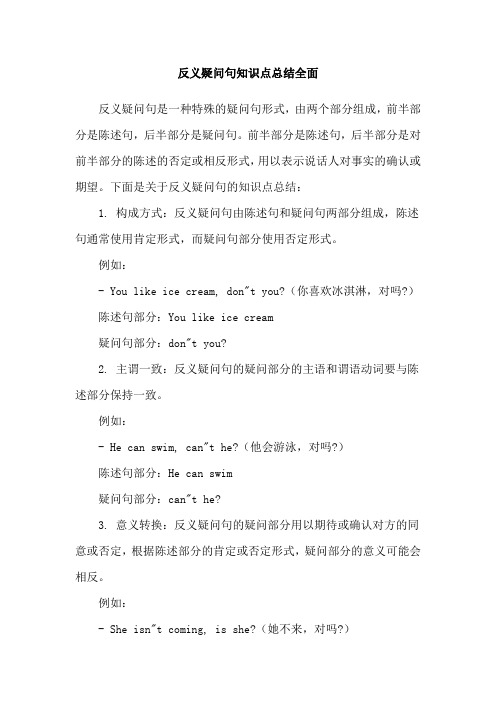
反义疑问句知识点总结全面反义疑问句是一种特殊的疑问句形式,由两个部分组成,前半部分是陈述句,后半部分是疑问句。
前半部分是陈述句,后半部分是对前半部分的陈述的否定或相反形式,用以表示说话人对事实的确认或期望。
下面是关于反义疑问句的知识点总结:1. 构成方式:反义疑问句由陈述句和疑问句两部分组成,陈述句通常使用肯定形式,而疑问句部分使用否定形式。
例如:- You like ice cream, don"t you?(你喜欢冰淇淋,对吗?)陈述句部分:You like ice cream疑问句部分:don"t you?2. 主谓一致:反义疑问句的疑问部分的主语和谓语动词要与陈述部分保持一致。
例如:- He can swim, can"t he?(他会游泳,对吗?)陈述句部分:He can swim疑问句部分:can"t he?3. 意义转换:反义疑问句的疑问部分用以期待或确认对方的同意或否定,根据陈述部分的肯定或否定形式,疑问部分的意义可能会相反。
例如:- She isn"t coming, is she?(她不来,对吗?)陈述句部分:She isn"t coming疑问句部分:is she?4. 祈使句的反义疑问句:当陈述部分是祈使句时,疑问部分使用肯定形式。
例如:- Open the window, will you?(请把窗户打开,好吗?)陈述句部分:Open the window疑问句部分:will you?5. 对待陈述的态度:反义疑问句可以表示说话人对陈述的态度,通常用于征求对方的意见或确认,或表示说话人的不确定或怀疑。
例如:- It"s a nice day, isn"t it?(今天天气不错,对吗?)陈述句部分:It"s a nice day疑问句部分:isn"t it?总结:反义疑问句是一种特殊的疑问句形式,用于征求对方的意见或确认,或表示说话人的态度。
反义疑问句知识点

反义疑问句知识点一、反义疑问句基本概念He likes walking with a stick, doesn’t he?He doesn’t like walking with a stick, does he?根据以上例句,我们可得出①反义疑问句的基本结构:_____________+____________②反义疑问句遵循的基本原则是________________________二、反义疑问句常见考点1.当陈述部分含有seldom, hardly, scarcely, never, few, little, nothing时,反句要用_________2.当陈述部分有表示“否定”意义的词缀时,陈述部分仍视肯定句,反问要用__________3.含有must的反义疑问句①当must 表推测,译为“一定”时,反问时,将must 去掉,根据句中的时态,确定陈述部分的谓语部分,再进行反问。
②当must 译为“必须”时,反问用needn’t③mustn’t 译为“禁止”,反问用must/ may练一练:You must be happy now, _______ _______?You must have heard about it, _________ _______?You must go now, ________ _______?You mustn’t smoke here, _________ ________?4.陈述部分含有used to do 译为“过去常常”时,反问可用used/did的相关形式5.陈述部分含有ought to do 时,反问用ought/should的相关形式6.陈述部分含有let’s 时,反问用shall we ; 陈述部分含有let sb 时,反问用will you7.肯定的祈使句反问用,will / won’t you; 否定的祈使句反问用will you.8.陈述部分含有think/ believe/ suppose/ expect/ imagine等引导的宾语从句时,若主语为第一人称时,应对从句进行反问;若主语为第二、三人称时,应对主句进行反问I believe he will succeed, _______ _______?I don’t believe he will succeed, _______ _______?He said he would come to my birthday party, _________ ________?①前肯后否的反义疑问句★②前否后肯的反义疑问句---- She is a teacher, isn’t she? ---- You aren’t a teacher, are you?---- Yes, she is ---- Yes, I am (不,我是)No, she isn’t No, I’m not(是,我不是)注意:①不存在no, I am 或者yes , I’m not的说法②前否后肯的反问做题技巧:现根据事实,确定后面的是/不是,再确定前面的yes/no③练一练:--- you haven’t been here long, have you? ----don’t you like classic music?---___________I am new here. -----__________. I’m interest in pop music。
英语语法易错知识点反意疑问句
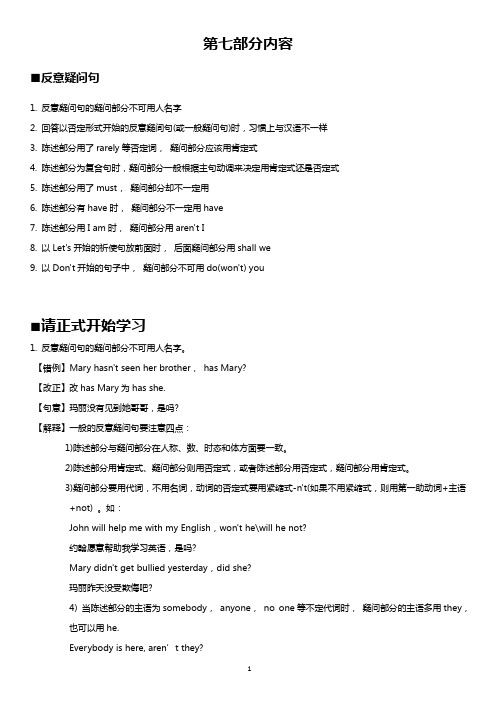
第七部分内容■反意疑问句1. 反意疑问句的疑问部分不可用人名字2. 回答以否定形式开始的反意疑间句(或一般疑问句)时,习惯上与汉语不一样3. 陈述部分用了rarely等否定词,疑问部分应该用肯定式4. 陈述部分为复合句时,疑问部分一般根据主句动调来决定用肯定式还是否定式5. 陈述部分用了must,疑问部分却不一定用6. 陈述部分有have时,疑问部分不一定用have7. 陈述部分用I am时,疑问部分用aren't I8. 以Let's开始的祈使句放前面时,后面疑问部分用shall we9. 以Don't开始的句子中,疑问部分不可用do(won't) you■请正式开始学习1. 反意疑问句的疑问部分不可用人名字。
【错例】Mary hasn't seen her brother,has Mary?【改正】改has Mary为has she.【句意】玛丽没有见到她哥哥,是吗?【解释】一般的反意疑问句要注意四点:1)陈述部分与疑问部分在人称、数、时态和体方面要一致。
2)陈述部分用肯定式、疑问部分则用否定式,或者陈述部分用否定式,疑问部分用肯定式。
3)疑问部分要用代词,不用名词,动词的否定式要用紧缩式-n't(如果不用紧缩式,则用第一助动词+主语+not) 。
如:John will help me with my English,won't he\will he not?约翰愿意帮助我学习英语,是吗?Mary didn't get bullied yesterday,did she?玛丽昨天没受欺侮吧?4) 当陈述部分的主语为somebody,anyone,no one等不定代词时,疑问部分的主语多用they,也可以用he.Everybody is here, aren’t they?No one was hurt,were they?Somebody borrowed my pen yesterday,didn't they?2. 回答以否定形式开始的反意疑问句(或一般疑问句)时,习惯上与汉语不一样。
知识点8(反义疑问句)

一、 反义疑问句的结构(1) 反义疑问句也称为附加疑问句,其结构如下:肯定形式陈述句+否定形式的疑问句即:陈述句+简短的疑问句(前肯后否,前否后肯) 否定形式陈述句+肯定形式的疑问句例:They are your friends, aren ’t they?She isn ’t beautiful, is she?Tony works hard, doesn’t he?Mary doesn ’t sing well, does she?二、 反义疑问句中的简短疑问句的结构(1) 简短疑问句的结构一般为:助动词+人称代词(主格)(2) 疑问句中助动词的选择:例:They are your friends, aren ’t they?She isn ’t beautiful, is she?Mary was busy yesterday, wasn ’t she?Tom can drive a car, can ’t he?Mary can ’t cook the meals, can she?Tony works hard, doesn’t he?Mary doesn ’t sing well, does she?Your parents played basketball yesterday, didn ’t they?(3) 疑问句中人称代词● 疑问句中的人称代词要用主格,且一般与陈述句中的主语保持一致。
例:Mary is a student, isn ’t she?Mr. Zhuo doesn’t do morning exercises every morning, does he?● 当陈述句的主语是something, anything, everything ,nothing 等表示物体的不定代词时,疑问句中的人称代词通常用it.Everything is ready, is it?●当陈述句中的主语是somebody, anybody, everybody, nobody, someone等表示人的不定代词时,疑问句的人称代词通常用he或者they.例:Everybody is here,isn’t he?三、反义疑问句中需注意的地方●当陈述句中含有表示否定意义的词语的时候,陈述句当成是否定形式的陈述句,那么疑问句中要用肯定形式。
反义疑问句归纳整理
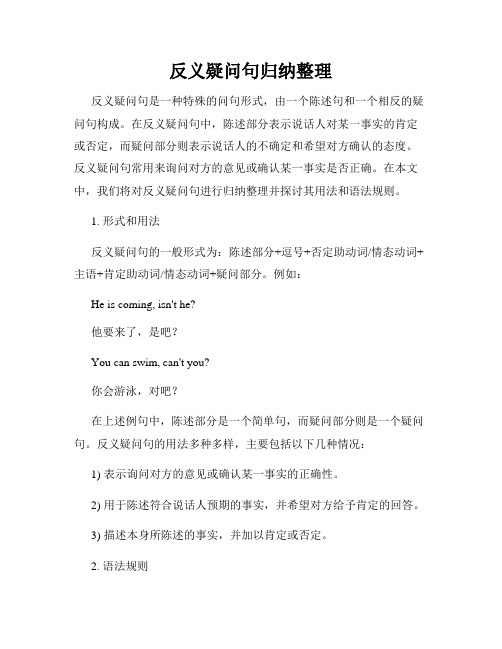
反义疑问句归纳整理反义疑问句是一种特殊的问句形式,由一个陈述句和一个相反的疑问句构成。
在反义疑问句中,陈述部分表示说话人对某一事实的肯定或否定,而疑问部分则表示说话人的不确定和希望对方确认的态度。
反义疑问句常用来询问对方的意见或确认某一事实是否正确。
在本文中,我们将对反义疑问句进行归纳整理并探讨其用法和语法规则。
1. 形式和用法反义疑问句的一般形式为:陈述部分+逗号+否定助动词/情态动词+主语+肯定助动词/情态动词+疑问部分。
例如:He is coming, isn't he?他要来了,是吧?You can swim, can't you?你会游泳,对吧?在上述例句中,陈述部分是一个简单句,而疑问部分则是一个疑问句。
反义疑问句的用法多种多样,主要包括以下几种情况:1) 表示询问对方的意见或确认某一事实的正确性。
2) 用于陈述符合说话人预期的事实,并希望对方给予肯定的回答。
3) 描述本身所陈述的事实,并加以肯定或否定。
2. 语法规则在构成反义疑问句的过程中,需要遵循一些语法规则,以确保句子的正确性和逻辑性。
2.1 句子主语在反义疑问句中,疑问部分的主语通常与陈述部分一致。
例如:She likes ice cream, doesn't she?她喜欢冰淇淋,对吧?You have finished your homework, haven't you?你完成了作业,是吧?2.2 肯定和否定疑问部分的肯定或否定助动词/情态动词取决于陈述部分的肯定或否定。
如果陈述部分是肯定的,疑问部分的助动词/情态动词是否定形式,反之亦然。
例如:He doesn't like chocolate, does he?他不喜欢巧克力,对吧?They can't swim, can they?他们不会游泳,是吧?2.3 时态和语态反义疑问句的时态和语态一般与陈述部分保持一致。
例如:She has been to Paris, hasn't she?她去过巴黎,是吧?The book wasn't written by him, was it?这本书不是他写的,对吧?3. 总结反义疑问句是一种特殊的问句形式,常用来询问对方的意见或确认某一事实的正确性。
初识反意疑问句

初识反意疑问句初识反意疑问句的知识点如下:1.反意疑问句的定义: 反义疑问句,表示说话人提出看法、建议或意见,问对方同意与否。
2. 反意疑问句的结构:有两部分组成,前一部分为陈述形式,后一部分为疑问句。
3. 反意疑问句的形式:前肯后否与前否后肯。
例: Lucy isn't beautiful, is she?露西不漂亮,是吗?Li Ming is pretty handsome, isn't he?黎明相当帅,不是吗?4. 反意疑问句的回答:肯定回答:“Yes+肯定结构”,否定回答“No+否定结构”,但是注意“Yes”要译为“不”,“No”要译为“是”。
例: -Your sister is a teacher, isn't she?你妹妹是老师,不是吗?-Yes, she is. 不,她是老师。
-You can play the guitar, can't you?你会弹吉他,不是吗?-No, I can't. 是的,我不会。
5. 反意疑问句的类型:(1)、be型例: The weather is fine, isn't it?天气很好,不是吗?The dress isn't blue, is it? 那件裙子不是蓝色的,是吗?(2)、助动词型Tom has a basketball, doesn't he?汤姆有一个篮球,不是吗?Your father often doesn't get up at six thirty, does he?你爸爸通常不在六点半起床,是吗?You want to be an artist when you grow up, don't you?当你长大后你想当一名艺术家,不是吗?All the students don't like wearing the school uniform, do they? 所有的学生都不喜欢在学校穿校服,是吗?(3)、情态动词型You will go to Beijing, won't you?你将去北京,不是吗?My son can't work out this question, can he?我儿子不会做这道题,是吗?。
反义疑问句知识点

反义疑问句反义疑问句:在陈述句后附加一个简短的疑问句,可以表示疑问,也可以表示说话者的某种倾向,强调或反问。
反义疑问句通常由两个词组成:第一个词是be、情态动词、助动词;若为否定,not用简略形式。
第二个词是人称代词主格(与陈述句主语相同)。
例:……,can't we? 和……,can we?⑴一般情况下:前面陈述句是肯定句,后面反义疑问句部分用否定;即“前肯定后否定,前否定后肯定”。
⑵当陈述句部分有表示否定或部分否定意义的词如little,barely,hardly,rarely,scarcely,seldom,few,no,never,nothing,not等词时,反意疑问句部分要用肯定形式。
You can hardly blame Tom for leaving early, can you?你不能责怪汤姆提前离开,是吗?当陈述句部分中表示否定意义的词为含有im-,in-,dis-,un-等否定前缀或-less等否定后缀的词时,应把陈述句部分视为肯定句,反意疑问句部分要用否定形式。
(有否定意义,但不能算否定词)Tom dislikes the book,doesn't he? 汤姆不喜欢这本书,是吗?⑶陈述句主语不同情况①当陈述句部分的主语是everyone,someone,anyone,no one,everybody,somebody,anybody,nobody等表示人的不定代词时,反意疑问句部分的主语通常用he,但口语多用they;Nobody wants to go here,does he/do they?没有人想去那里,是不是?②当陈述句部分的主语是anything,everything,nothing,something 等表示物的不定代词时,反意疑问句部分的主语常用it.Everying seems all right now,doesn't it?似乎一切顺利,是不是?②当陈述句部分的主语是I 时,反意疑问句部分的主语常用aren't I.若表示征询对方意见时,疑问句部分用do you.I am healthy,aren't I?我很健康,对吗?I don't like this film,do you?我不喜欢这部电影,你呢?④当陈述句部分的主语是不定式(短语)或动名词(短语)时,反意疑问句部分的主语常用it.Learning English well takes a long time,doesn't it?学好英语需要好长时间,是不是?②当陈述部分的主语是指示代词this /that或these /those时,疑问句中的主语分别用it或theyThis is important, isn't it? 此事很重要,是不是?②如果陈述部分是以代词one作主语疑问句的主语,在正式场合用one 非正式场合用you在美国英语中非正式场合下,还可以用heOne cannot be too careful, can one /can you? 越仔细越好,对不对?②陈述部分有neither…nor 或both …and连接两个主语时,疑问句部分的主语常用复数形式。
反义疑问句(最全)

4.陈述部分有had better + v. 疑问句部分用hadn’t you? You’d better read it by yourself, hadn’t you? 5.陈述部分是“there be”结构时,疑问部分用there省略主语代词。 There is something wrong with your watch, isn't there? There will not be any trouble, will there? Note: 当为“ there used to be…”句型时,反意问句用didn’t there。
反义疑问句
Question Tags
演讲人姓名
CLICK HERE TO ADD A TITLE
附加疑问句
附加疑问句(Question Tags)又叫反意疑问句。反意疑问句由两部分组成:前一部分是一个陈述句,后一部分是一个简短的疑问句,两部分的人称时态应保持一致。
ห้องสมุดไป่ตู้
question tags
有情态动词的反意疑问句
(一)句中陈述部分没有表示过去的时间状语,这时疑问部分中的动词就用现在完成时。 (haven’t / hasn’t + 主语) You must have told her about it, haven’t you? (二)陈述部分有表示过去的时间状语,疑问部分的动词就用一般过去时。(didn’t + 主语) She must have read the novel last week, didn’t she?
三、特殊句型的反义疑问句: 省去主语的祈使句的反意疑问句,疑问部分用will you。 Don’t do that again, will you? Go with me, will you / won’t you ? 这里就不符合“前否后肯”的原则,而是“前肯后可肯可否” Note : Let‘s 开头的祈使句,后用shall we? Let's go and listen to the music, shall we/shan't we? Let us 开头的祈使句,后用will you? Let us wait for you in the reading-room, will you/won't you?
反义疑问句知识点总结全面
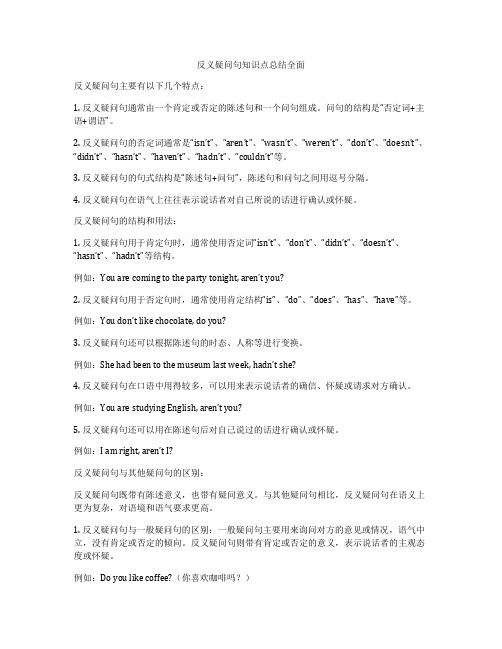
反义疑问句知识点总结全面反义疑问句主要有以下几个特点:1. 反义疑问句通常由一个肯定或否定的陈述句和一个问句组成。
问句的结构是“否定词+主语+谓语”。
2. 反义疑问句的否定词通常是“isn’t”、“aren’t”、“wasn’t”、“weren’t”、“don’t”、“doesn’t”、“didn’t”、“hasn’t”、“haven’t”、“hadn’t”、“couldn’t”等。
3. 反义疑问句的句式结构是“陈述句+问句”,陈述句和问句之间用逗号分隔。
4. 反义疑问句在语气上往往表示说话者对自己所说的话进行确认或怀疑。
反义疑问句的结构和用法:1. 反义疑问句用于肯定句时,通常使用否定词“isn’t”、“don’t”、“didn’t”、“doesn’t”、“hasn’t”、“hadn’t”等结构。
例如:You are coming to the party tonight, aren’t you?2. 反义疑问句用于否定句时,通常使用肯定结构“is”、“do”、“does”、“has”、“have”等。
例如:You don’t like chocola te, do you?3. 反义疑问句还可以根据陈述句的时态、人称等进行变换。
例如:She had been to the museum last week, hadn’t she?4. 反义疑问句在口语中用得较多,可以用来表示说话者的确信、怀疑或请求对方确认。
例如:You are studying English, aren’t you?5. 反义疑问句还可以用在陈述句后对自己说过的话进行确认或怀疑。
例如:I am right, aren’t I?反义疑问句与其他疑问句的区别:反义疑问句既带有陈述意义,也带有疑问意义。
与其他疑问句相比,反义疑问句在语义上更为复杂,对语境和语气要求更高。
1. 反义疑问句与一般疑问句的区别:一般疑问句主要用来询问对方的意见或情况,语气中立,没有肯定或否定的倾向。
九年义务初中英语反义疑问句必考知识点归纳

1.助动词的变化:反义疑问句的结构为“肯定句+否定疑问句”,主谓一致的原则在反义疑问句中同样适用。
因此,如果肯定句中使用了助动词,反义疑问句中要用与之相对的否定助动词,例如:He is a student, isn't he?She can swim, can't she?2.人称代词的变化:当反义疑问句的主语是第三人称单数时,需要在反义疑问句中用适当的人称代词代替原来的主语。
例如:Tom likes playing football, doesn't he?The baby is sleeping, isn't he?3.情态动词的变化:反义疑问句中情态动词的变化也需要注意。
例如:You should finish your homework, shouldn't you?She must be tired, mustn't she?4.肯定/否定形容词和副词的转换:当肯定形容词或副词出现在肯定句中时,反义疑问句中要用相应的否定形式。
例如:She is happy, isn't she?He often goes to the park, doesn't he?5.反义疑问句的意义转换:有时候,反义疑问句并不仅仅是为了确认信息,还可能用于提出建议或请求对方的意见。
在这种情况下要注意将反义疑问句的语气从肯定转换为否定或反过来。
例如:Let's go for a walk, shall we?You wouldn't mind helping me, would you?需要注意的是,以上提到的知识点是九年义务初中英语中比较常见的反义疑问句的考点,但并不会涵盖所有的情况。
在学习过程中,要结合实际语境多进行练习,掌握更多的用法和变形。
九年义务初中英语反义疑问句知识点归纳总结
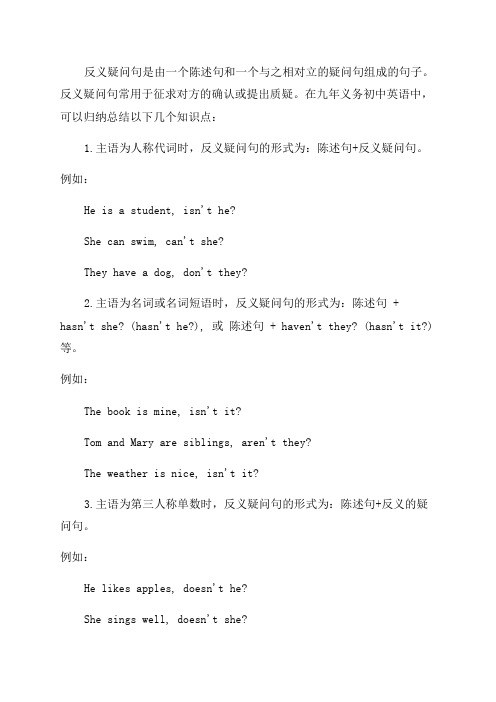
反义疑问句是由一个陈述句和一个与之相对立的疑问句组成的句子。
反义疑问句常用于征求对方的确认或提出质疑。
在九年义务初中英语中,可以归纳总结以下几个知识点:1.主语为人称代词时,反义疑问句的形式为:陈述句+反义疑问句。
例如:He is a student, isn't he?She can swim, can't she?They have a dog, don't they?2.主语为名词或名词短语时,反义疑问句的形式为:陈述句 + hasn't she? (hasn't he?), 或陈述句 + haven't they? (hasn't it?)等。
例如:The book is mine, isn't it?Tom and Mary are siblings, aren't they?The weather is nice, isn't it?3.主语为第三人称单数时,反义疑问句的形式为:陈述句+反义的疑问句。
例如:He likes apples, doesn't he?She sings well, doesn't she?The dog is hungry, isn't it?4.肯定句变为反义疑问句时,助动词的形式相反。
如有be动词,则需将be动词的形式(is, am, are, was, were)改为否定形式(isn't, aren't, wasn't, weren't),有情态动词则直接将情态动词后的动词改为否定形式。
如can改为can't, could改为couldn't等。
5.否定句变为反义疑问句时,需要将否定词去掉,并将动词改为肯定形式。
例如:You didn't eat breakfast, did you?He doesn't like football, does he?They haven't finished their homework, have they?。
(完整版)反义疑问句用法归纳
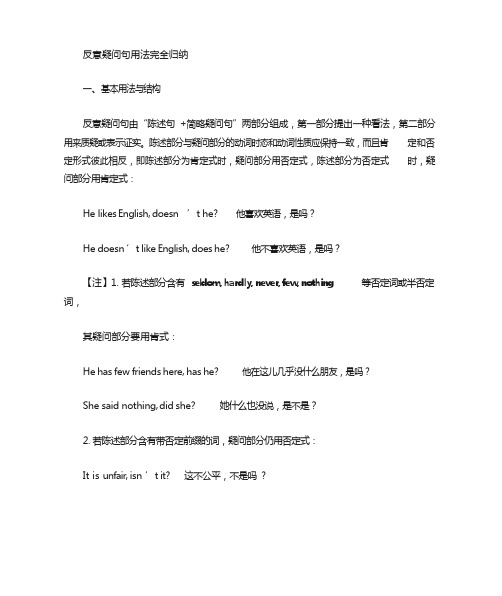
反意疑问句用法完全归纳一、基本用法与结构反意疑问句由“陈述句+简略疑问句”两部分组成,第一部分提出一种看法,第二部分用来质疑或表示证实。
陈述部分与疑问部分的动词时态和动词性质应保持一致,而且肯定和否定形式彼此相反,即陈述部分为肯定式时,疑问部分用否定式,陈述部分为否定式时,疑问部分用肯定式:He likes English, doesn ’t he? 他喜欢英语,是吗?He doesn ’t like English, does he? 他不喜欢英语,是吗?【注】1. 若陈述部分含有seldom, hardly, never, few, nothing 等否定词或半否定词,其疑问部分要用肯式:He has few friends here, has he? 他在这儿几乎没什么朋友,是吗?She said nothing, did she? 她什么也没说,是不是?2. 若陈述部分含有带否定前缀的词,疑问部分仍用否定式:It is unfair, isn ’t it? 这不公平,不是吗?It is impossible, isn ’t it? 那是不可能的,是吗 ?二、反意疑问句的主语问题1.基本原则:疑问部分的主语应与陈述部分主语一致,且只能是代词:Mary is a nurse, isn’t she? 玛丽是护士,对吗?2.当陈述部分为there be 句型时,疑问部分仍用there 作“主语”:There was nothing in the room, was there? 房间里什么也没有,是吗?3.当陈述部分的主语是指示代词时,疑问部分用it, they 等代词:That is a new car, isn ’t it? 这是一辆新汽车,是吗?4.当陈述部分的主语是复合不定代词时,若陈述部分的主语为somebody, someone, everyone, everybody, no one, nobody 等复合不定代词,其反意疑问句的主语在正式文体中用he ,在口语或非正式文体中通常用they :Nobody was late, were they? 没有一个人迟到,是吗 ?5.当陈述部分的主语是something, anything, nothing, everything 等复合不定代词时,其反意疑问句的主语要用it:Everything is ready, isn ’t it? 一切都准备好了吗?Nothing is important, is it? 没有什么重要的,不是吗 ?三、陈述部分有动词 have 的反意疑问句1.当have 为助动词时,其反意疑问句沿用同样的助动词:He has already left, hasn ’t he? 他已经离开了,是吗 ?2.当 have 为实意动词时,要分两种情况:①若表示“所有”,反意疑问句可以用h ave,也可以用do:He has a lot of friends here, hasn ’t [doesn ’t] he? 他在这儿有许多朋友,是吗?但是若陈述部分用的是have 的否定式,反意疑问句用have 还是用 do,取决于陈述部分的动词形式:He hasn ’t any money, has he? 他没有钱,是吗 ?He doesn ’t have any money, does he? 他没有钱,是吗 ?②若表示“吃”、“玩”等意思,反意疑问句要用do:He has supper at 5, doesn ’t he? 他 5 点吃晚餐,是吗 ?He had a good time at the party, didn ’t he? 他在晚会上玩得很开心,是吗 ?3.当用于have to 时,通常也有两种可能:若表示经常性的行为,则多用加助动词do 的形式;若表示特定的行为,则多用have :He often has to get up early, doesn ’t he? 他经常要早起,是吗?He has to go to bed late tonight, hasn ’t he? 他今晚要迟睡,是吗 ?四、含情态动词的反意疑问句1.基本原则:在通常情况下,当陈述部分含有情态动词时,疑问部分会重复前面同样的情态动词:He can speak English, can ’t he ?他会说英语,是吗?Weshouldn ’t go, s hould we? 我们不应该去,对不对?2.当陈述部分含有must 时,要分两种情况:①若must表示“必须”或“有必要”,疑问部分用mustn’t或needn’t:Y ou must leave at once, mustn ’t [needn ’t] you? 你必须(有必要) 马上离开,是吗 ?但是若陈述部分有 mustn ’t 表示禁止,疑问部分要must :Y ou mustn ’t laugh, must you? 你不准笑,知道吗 ?② 若 must 表示推测,疑问部分不能用 must ,而应根据 must 后的动词结构采用相应的动词形式:He must be tired, isn ’t he? 他一定累了,是吗 ?五、陈述部分为祈使句的反意疑问句1.基本原则:若陈述部分为祈使句,疑问部分通常用will you :Please help us, will you? 请帮帮我们,好吗?Come with us, will you? 同我们一起去,好吗?Don’t forget to p ost the le t t er, will you? 请别忘了寄信。
反义疑问句知识点总结
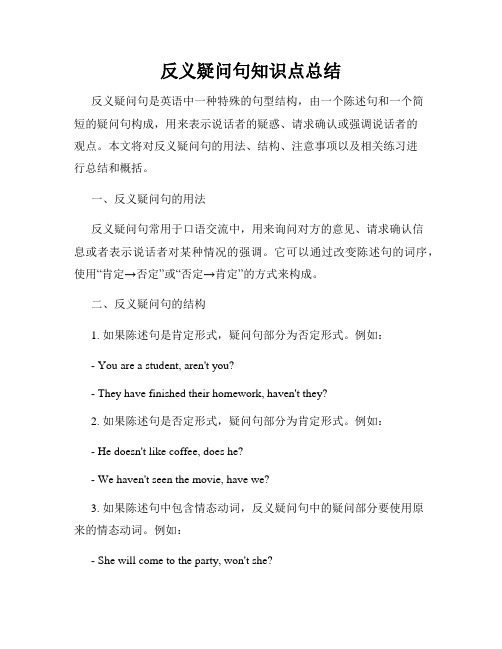
反义疑问句知识点总结反义疑问句是英语中一种特殊的句型结构,由一个陈述句和一个简短的疑问句构成,用来表示说话者的疑惑、请求确认或强调说话者的观点。
本文将对反义疑问句的用法、结构、注意事项以及相关练习进行总结和概括。
一、反义疑问句的用法反义疑问句常用于口语交流中,用来询问对方的意见、请求确认信息或者表示说话者对某种情况的强调。
它可以通过改变陈述句的词序,使用“肯定→否定”或“否定→肯定”的方式来构成。
二、反义疑问句的结构1. 如果陈述句是肯定形式,疑问句部分为否定形式。
例如:- You are a student, aren't you?- They have finished their homework, haven't they?2. 如果陈述句是否定形式,疑问句部分为肯定形式。
例如:- He doesn't like coffee, does he?- We haven't seen the movie, have we?3. 如果陈述句中包含情态动词,反义疑问句中的疑问部分要使用原来的情态动词。
例如:- She will come to the party, won't she?- They can swim, can't they?4. 如果陈述句中使用了“let's”来表示建议,反义疑问句中疑问部分要使用“shall we”。
例如:- Let's go for a walk, shall we?5. 如果陈述句中使用了“there is”或“there are”,反义疑问句中疑问部分要使用“isn't there”或“aren't there”。
例如:- There is a book on the table, isn't there?三、注意事项1. 反义疑问句的结构要与陈述句的主语保持一致。
- She is a doctor, isn't she?(正确)- She is a doctor, aren't you?(错误)2. 主语如果是第三人称单数,疑问句的代词要使用对应的第三人称代词,即“he、she、it”。
反意疑问句知识点总结

反意疑问句是英语四大问句之一,它是由一个陈述句加上一个短问句而构成的。
反意疑问句的基本构成形式是:陈述句+动词(肯定或否定)+主语?如:①She often has lunch at school, doesn’t she? ②You don’t like sports, do you?使用反意疑问句要注意以下若干对应规则:一、反意疑问句中问句部分的动词与陈述部分的动词在语气上成相反的对应关系,即:肯定+否定?否定+肯定?如:①You can’t do it, can you? ②They are very late for the meeting, aren’t they?二、反意疑问句中问句部分的动词与陈述部分的动词种类要对应一致。
如:①He has supper at home every day, doesn’t he? (不能用hasn’t he?)②They have known the matter, haven’t they? (不能用don’t they?)三、反意疑问句中问句部分的动词在时态上应和陈述部分的时态一致。
如:①They will go to town soon, won’t they?(不能用don’t they?或aren’t they?)②He works very hard, doesn’t he?(不能用didn’t he?或won’t he?)四、反意疑问句的陈述部分含有由un-, im-, in-, dis-, 等否定意义的前缀构成的词语时,陈述部分要视为肯定含义,问句部分用否定形式。
如:①Your father is unhappy, isn’t he?(不能用is he?)②The man is dishonest, isn’t he? (不能用is he?)③It is impossible to learn English without remembering more words, isn’t it?(不能用is it ?)五、反意疑问句的陈述部分带有little, few, never, hardly, seldom等否定意义的词时,问句部分用肯定式。
- 1、下载文档前请自行甄别文档内容的完整性,平台不提供额外的编辑、内容补充、找答案等附加服务。
- 2、"仅部分预览"的文档,不可在线预览部分如存在完整性等问题,可反馈申请退款(可完整预览的文档不适用该条件!)。
- 3、如文档侵犯您的权益,请联系客服反馈,我们会尽快为您处理(人工客服工作时间:9:00-18:30)。
反意疑问句是英语四大问句之一,它是由一个陈述句加上一个短问句而构成的。
反意疑问句的基本构成形式是:陈述句+动词(肯定或否定)+主语?如:①She often has lunch at school, doesn’t she? ②You don’t like sports, do you?使用反意疑问句要注意以下若干对应规则:一、反意疑问句中问句部分的动词与陈述部分的动词在语气上成相反的对应关系,即:肯定+否定?否定+肯定?如:①You can’t do it, can you? ②They are very late for the meeting, aren’t they?二、反意疑问句中问句部分的动词与陈述部分的动词种类要对应一致。
如:①He has supper at home every day, doesn’t he? (不能用hasn’t he?)②They have known the matter, haven’t they? (不能用don’t they?)三、反意疑问句中问句部分的动词在时态上应和陈述部分的时态一致。
如:①They will go to town soon, won’t they?(不能用don’t they?或aren’t they?)②He works very hard, doesn’t he?(不能用didn’t he?或won’t he?)四、反意疑问句的陈述部分含有由un-, im-, in-, dis-, 等否定意义的前缀构成的词语时,陈述部分要视为肯定含义,问句部分用否定形式。
如:①Your father is unhappy, isn’t he?(不能用is he?)②The man is dishonest, isn’t he? (不能用is he?)③It is impossible to learn English without remembering more words, isn’t it?(不能用is it ?)五、反意疑问句的陈述部分带有little, few, never, hardly, seldom等否定意义的词时,问句部分用肯定式。
如:①She never tells a lie, does she?(不用doesn’t she?)①She never tells a lie, does she?(不用doesn’t she?)②He was seldom late, was he?(不用wasn’t he?)六、反意疑问句的陈述部分为I am……时,问句部分习惯上用aren’t I?表示。
如:I am a very honest man, aren’t I?七、反意疑问句的陈述部分为I(We) think(believe,suppose, consider) + that从句时,问句部分的动词及主语与that从句内的动词和主语保持一致。
如:①I think that he has done his best, hasn’t he?②We think that English is very useful, isn’t it? (不用don’t we?)八、反意疑问句的陈述部分为I(We) don’t think(believe,suppose, consider)+ that从句时,从句为否定意义,问句部分的动词和主语仍与that从句保持一致且用肯定式。
如:①I don’t think that you can do it, can you? (不用do I?)②We don’t believe that the news is true, is it? (不用dowe?)九、反意疑问句的陈述部分为非第一人称主语+think(believe, suppose, consider) + that从句时,问句部分的动词和主语与陈述部分的主句动词和主语保持一致。
如:①They all think that English is very important, don’t they?(不用is②He didn’t think that the news was true, did he? (不用wasn’t/ was it?)十、反意疑问句的陈述部分为主语+said( told, reported,asked……) + that从句时,问句部分的动词和主语与陈述部分的主句动词和主语保持一致。
如:①They said that you had finished your work, didn’t they?(不用hadn’t you)②Kate told you that she would go there, didn’t she? (不用wouldn’t she?)十一、陈述部分的主语为不定代词something, anything, nothing, everything时,问句部分的主语用it。
如:①Something is wrong with the computer, isn’t it?②Nothing has happened to them, has it?十二、陈述部分的主语为不定代词somebody(someone), anybody(anyone), nobody(no one), everybody(everyone)时,问句部分的主语用he或they,这时问句动词的数应和he 或they一致。
如:①Someone has taken the seat, hasn’t he?②Everyone has done their best in the game, haven’t they?十三、陈述部分为Let me……时,问句部分习惯上用shall I? 或will you?形式。
如:Let me have a try, shall I?(will you?)十四、陈述部分为Let us……时,问句部分习惯上用will you?形式。
如:Let us stop to rest, will you?十五、陈述部分为Let’s……时,问句部分习惯上用shall we?形式。
如:Let’s go home together, shall we?十六、陈述部分用上述情况以外的祈使句时,问句部分一般用will you?形式表示请求,用won’t you?形式表示委婉请求或邀请。
如:①Do sit down, won’t you?/ will you?③Please open the window, will you?(won’t you?)十七、陈述部分为否定祈使句时,问句部分一般用will you?形式。
如:Don’t make any noise, will you?十八、陈述部分为There (Here) + be + 主语时,问句部分用动词+there(here)?形式。
如:①There are two cakes on the plate, aren’t there? ②Here isa story about Mark Twain, isn’t here?十九、陈述部分用had better +原形动词表示建议时,问句部分用hadn’t +主语?形式。
①You’d better tell him about the matter, hadn’t you?②We had better do it by ourselves, hadn’t we?二十、陈述部分用used to +主语时,问句部分用didn’t + 主语?或usedn’t +主语?形式。
①He used to live in the country, didn’t he?/usedn’t he?②They used to be good friends, didn’t they?/usedn’t they? 二十一、陈述部分用must(may, might) + have + V-ed表示推测时,若句中带有明显的过去时间的状语,问句部分动词用过去时形式。
如:①He might have forgotten his pen in the classroom yesterday, didn’t he?(不用mightn’t he?/ hasn’t he?)②You must have got up late this morning, didn’t you?(不用mustn’t you?/haven’t you?)二十二、陈述部分用must(may, might) + have + V-ed表示推测时,若句中没有带明显的过去时间的状语,问句部分动词用现在完成时形式。
如:①Everyone must have known the death of the waitress, haven’t they? (不用mustn’t they?)②You must have worked there a year ago, didn’t you?(不用mustn’t you?/ haven’t you?)二十三、陈述部分的主语为从句时,问句部分的主语一般用it代替,如:①What he said is true, isn't it? (不用didn’t he?)②Where we will build the dam has not been decided yet, has it? (不用won’t we?)二十四、陈述部分的主语为动名词或不定式时,问句的主语用it代替。
如:①To do one good deed is easy for a person, isn't it?②Skating is your favorite sport, isn't it?二十五、感叹句的反意疑问句感叹句中,疑问部分用be +主语。
What colours, aren't they?What a smell, isn't it?二十六Must的反意疑问句陈述部分有must 的疑问句,疑问部分根据实际情况而定。
A.must表示“应该”,其疑问部分用mustn't(不应该),如:You must work hard next term, mustn't you ? 下学期你应该努力学习,对吗?B.must表示“必须”,其疑问部分用needn't(不必),如:They must finish the work today, needn’t they? 他们今天必须要完成这项工作,是吗?C.陈述部分含情态动词mustn't,表示禁止时,疑问部分就可以用must或may,如:You mustn’t stop your car here, must you? (may we?)你不能把车停在这地方,知道吗?D.must表示推测,其疑问部分必须与must 后面的主要动词相呼应。
